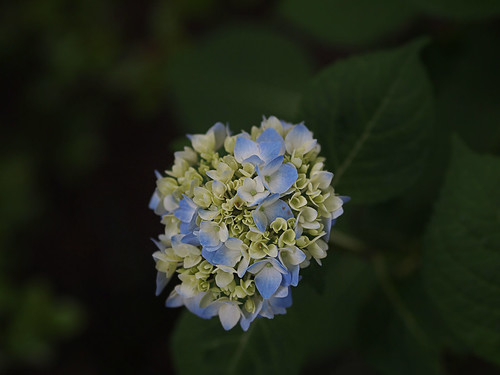Saturdays, here, it's usually a photo of a beer or a brewery (or wine, whiskey, but not song). Today, on the other hand, the Pic(k) of the Week is of a blooming hydrangea.
Hydrangea (or hortensia) is a genus of 70–75 species of flowering plants native to southern and eastern Asia (China, Japan, Korea, the Himalayas, and Indonesia) and the Americas. By far the greatest species diversity is in eastern Asia, notably China, Japan, and Korea. Most are shrubs 1 to 3 meters tall, but some are small trees, and others lianas reaching up to 30 m (98 ft) by climbing up trees. They can be either deciduous or evergreen, though the widely cultivated temperate species are all deciduous.
And, here, from the website of the United States National Arboretum (that is, before budget cuts take it down):
While there are approximately 23 species of Hydrangea, only five are widely cultivated in the U.S. The most popular species is Hydrangea macrophylla, which is commonly known as bigleaf, French, garden or florist’s hydrangea. This Japanese native is rated as hardy to USDA cold-hardiness zone 6. It produces large inflorescences of white, pink or blue flowers in early summer. As with most other Hydrangea species, the inflorescence is composed of a combination of large, showy and small, inconspicuous flowers. In mophead, or Hortensia, (H. macrophylla var. macrophylla) cultivars, many showy flowers are arranged on the outside of the rounded inflorescence. On the interior of the inflorescence, a few small flowers are present; these are the flowers that produce seed.
And, finally, here, from The Farmer's Almanac:
With immense flower heads, hydrangeas flaunt an old-fashioned charm that is hard to resist. Colors also beguile with clear blues, vibrant pinks, frosty whites, lavender, and rose—sometimes all blooming on the same plant! The colors of some hydrangeas—especially mophead and lacecap—can change color based on the soil pH, which affects relative availability of aluminum ions. Acidic soils with a pH of less than 5.5 produce blue flowers; soils with a pH greater than 5.5 produce pink flowers. White flowers are not affected by pH. Unrivaled in the shrub world, these elegant ladies are easy to cultivate, tolerate almost any soil, and produce flowers in mid-summer through fall (when little else may be in bloom). Hydrangeas are excellent for a range of garden sites from group plantings to shrub borders to containers.
I took this image at 5:53 pm, on 30 April 2017, in the garden of a house in southeast Atlanta, Georgia, using a 'fast lens' on a Micro Four Thirds-format mirrorless digital camera.
- Camera: Olympus Pen E-PL1
- Lens: Olympus M.45mm F1.8
- ISO: 200
- Shutter speed: 1/400
- Aperture: f/2.0
- Focal length: 45 mm
(equivalent to DSLR range of 90 mm)
- Pic(k) of the Week: one in a weekly series of photos taken (or noted) by me, posted on Saturdays, and often, but not always (as is the case today), with a good fermentable as the subject.
- Camera: Olympus Pen E-PL1.
- Commercial reproduction requires explicit permission, as per Creative Commons.
- For more from YFGF:
- Follow on Twitter: @Cizauskas.
- Like on Facebook: YoursForGoodFermentables.
- Follow on Flickr: Cizauskas.
- Follow on Instagram: @tcizauskas.









No comments:
Post a Comment
Comment here ...